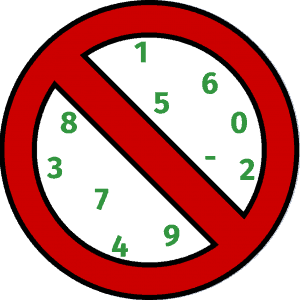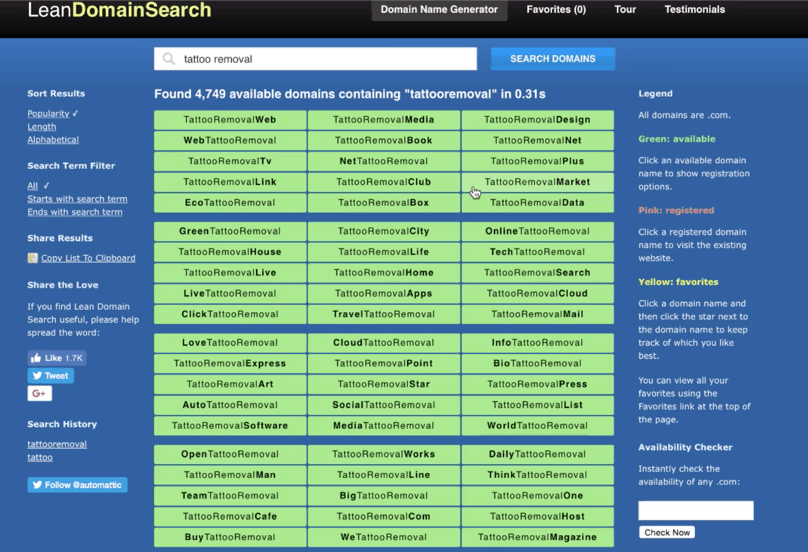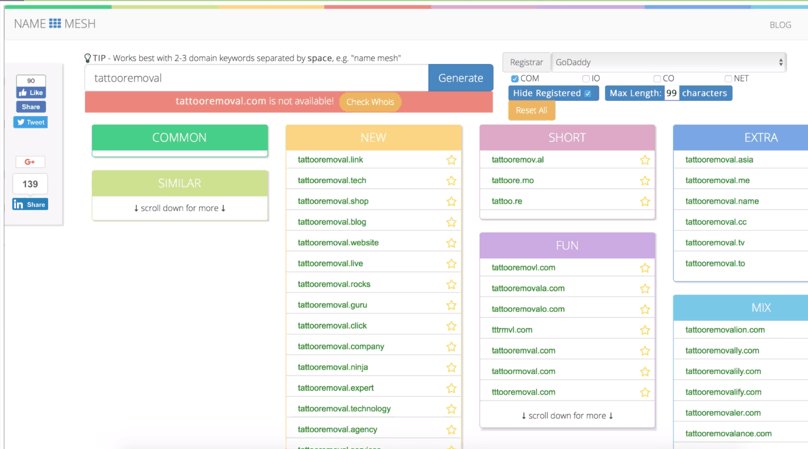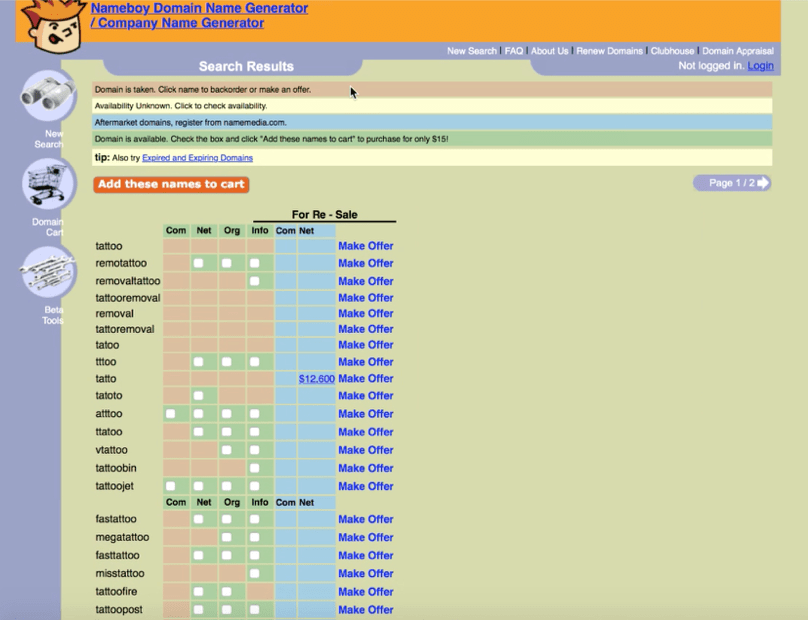The two essential components of building a website from scratch are:
- the domain name and
- hosting.
In the next two lessons, I’m going to discuss domain names: how to choose one and how to acquire one. Choosing a domain name is more time-consuming than people think, but it can be broken down into a simple set of rules.
Things to Know Before Choosing a Domain Name
People become alarmed when they can’t find and choose a blog name within an hour. That’s perfectly normal. It usually takes one to four hours to pinpoint a domain name, but it can also take six to eight hours over the course of two or three days.
Choosing a domain name is not something that’s possible to do within 10 minutes because there are checkboxes you want to make sure and check to ensure the domain’s workability. It’s going to take time to find a really good domain name, especially in somewhat saturated niches, but we’re going to look at tools that will help you immensely.

Changing Domain Names
Can you change your domain name if it’s wrong? The short answer is NO. The long answer is a little more complicated than that.
There is a way around selecting the wrong domain name, but it requires building a different website on a different domain name and transferring the content of the old site to the new one. It’s a very technical process that’s time-consuming and not something you want to spend your valuable time doing. So, you definitely want to get the domain name right the first time.
Beware of “Analysis Paralysis”
Falling into what I call “analysis paralysis” is easy to do because there are a lot of factors to consider when selecting the ideal domain name. It’s important to remember that you’re not going to find the “perfect” domain. Do the best you can by following this guide and using the free tools I’m going to share and hopefully you’ll get something, not perfect, but really, really good.
What Makes a Good Domain Name?
Old-school training dictates that an Exact Match Domain, or EMD, is the ideal domain name. EMDs are domain names that precisely match the search term that will drive traffic to your website. In the Men’s Supplements niche, people are using the term “men’s supplements” in search engines, so a domain name that matches that exact phrase, like MensSupplements.com for example, would constitute as an EMD. According to the old-school practice, websites with an EMD shoot straight to the top of search engine results pages.
It didn’t take long for spammers to abuse this advantage by purchasing EMDs, building sites with low-quality content, and watching their rankings zoom to the top without the hard work of building an actual helpful website. After a while, Google caught on and penalized EMD sites with low-quality content.
At the time people who owned a legitimate EMD site with high-quality content, useful internal and external links, and great site structure weren’t penalized for having an EMD site.
If you’ve gone through training that heavily promotes EMDs, forget it; EMDs aren’t going to give you an advantage over the competition anymore. So, what does?
Valuable content.
This early in the game it doesn’t matter what keywords are or aren’t in your domain name. The site will get ranked as long as you have valuable content.

How To Come Up With A Blog Name: The Anatomy of a Perfect Domain Name
What makes a domain name as close to perfect as you can get? Here are some basics of how to come up with a blog name listed in order of priority:
1. Use a “.com” domain suffix.
You’ll have a greater chance of ranking high in search engine results and getting brand recall with a “.com” suffix than any other domain suffix.
Think about it from your audience’s perspective: if a person goes to your website once, manages to catch the brand name, and wants to go back to your site at a later date, they’re going to type your domain name followed by “.com.” It’s second nature for most people, including you and me.
People will struggle to find your website if it’s registered under any other domain suffix. They may eventually find your site through Google searches, but that can turn into a multistep endeavor that’s easy to ditch.
2. Make your domain name memorable, brandable, and easy to spell.
The easier a domain name is to remember, the easier it is for it to be shared with others in person or through social media.
3. Shorter names are best.
Try to limit your domain name to two or three words so people can recall it easily. Admittedly, this particular rule might conflict with Rules 1 and 2 and make deciding on a domain name challenging. If you get really stuck trying to make sure your domain name follows all the rules, prioritize a “.com” suffix and making it memorable rather than shorter.
4. Avoid hyphens and numbers.
Hyphens and numbers are technically allowed in domain names, but this rule exists for a practical reason: hyphens are associated with low quality websites, and numbers are hard to spell because there’s confusion whether it needs to be the symbol (e.g., “1”) or the word (e.g., “one”).

5. Try to include a root keyword.
Using men’s supplements as an example, including the keyword “supplements” or “men’s” somewhere in the domain name will help people find your website much faster. These are chunks of your keyword that are going to be in a lot of search terms people use to find information online.
While it’s ideal to include part of your keyword in the domain name, if it goes against all of the previous rules, feel free to forget it. Again, valuable content is more important for your rankings than keywords in your domain name.
6. If you can’t find an acceptable “.com” domain name, opt for a “.net” or “.org” suffix.
Runner-ups in the domain suffix race would be “.net” or “.org” suffixes, albeit very distant ones. Suffixes other than the three listed here will be far less desirable. Some regional domain suffixes that are climbing in popularity include “.co,” “.nz,” and “.uk.” Count those regionally specific domain suffixes out because it’s going to severely inhibit your ability to rank worldwide.
Helpful Tools for Finding the Best Domain Name
VERY Important Note: Shortly before we published this training, Lean Domain Search dramatically redesigned their webpage, so your screens won’t quite match up with those in this training.
This tool is a domain name generator that takes your keyword and appends prefixes and suffixes to it to generate hundreds or thousands of domain names to choose from. The other neat feature of Lean Domain Search is its ability to check the availability of all the “.com” domain name results generated so you don’t have to check each one individually.
This is my absolute favorite tool because it generates good names that may not have immediately come to mind. For example, if I were to search the keyword “tattoo removal,” here’s what the results would look like:

Lean Domain Search results using the search query “tattoo removal”
All 4,700+ of these “.com” domain names are great options. The results can be sorted alphabetically, by popularity, and by length.
This tool has its uses, but it’s not as handy as Lean Domain Search. To contrast, check out this example search result for “tattoo removal:”

NameMesh.com search results with the search query “tattoo removal”
As you can see, the domain names generated aren’t very usable, but results in the “Common,” “Similar,” “SEO,” and “Mix” columns may serve as inspiration. I’ll take this opportunity to reiterate how ineffective domain suffixes other than “.com,” “.net,” and “.org” are.
VERY Important Note: Shortly before we published this training, Nameboy dramatically redesigned their webpage, so your screens won’t quite match up with those in this training.
This is another helpful tool, but, again, not as helpful as Lean Domain Search. Searching for “tattoo” as the primary keyword and “removal” as the secondary keyword would yield the following results:

NameBoy search results with the search query “tattoo” and “removal”
The results generated are an interesting mix between the results from Lean Domain Search and NameMesh.